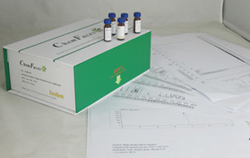Hot Products



| Catalog No. | Information |
| CFN90677 | Protopseudohypericin Reference standards. |
| CFN96956 | Protosappanin A Protosappanin A has anti-oxidative/nitrative activities on brain immune and neuroinflammation through regulation of CD14/TLR4-dependent IKK/IκB/NF-κB inflammation signal pathway; it exerts anti-neuroinflammatory effect by inhibiting JAK2-STAT3 pathway in lipopolysaccharide-induced BV2 microglia. Protosappanin A induces immunosuppression of rats heart transplantation targeting T cells in grafts via NF-kappaB pathway. Protosappanin A and protosappanin B have antimicrobial activity, they show both alone activities and resistance reversal effects of amikacin and gentamicin against MRSA. Protosappanin A shows strong effect against HIV-1 IN with an IC50 value of 12.6 uM. |
| CFN90135 | Protosappanin B Protosappanin B possesses antitumor, anti-inflammation and anti-oxidation properties, it protects PC12 cells against oxygen–glucose deprivation-induced neuronal death by maintaining mitochondrial homeostasis via induction of ubiquitin-dependent p53 protein degradation. |
| CFN80139 | Protostemonine Protostemonine has anti-inflammatory activity, it effectively attenuates LPS-induced inflammatory responses in vitro and in vivo; the beneficial effects are associated with the decreased phosphorylation of MAPK and AKT and the reduced expression of pro-inflammatory mediators, such as iNOS, NO and cytokines. Protostemonine shows significant antitussive activity in a citric acid-induced guinea pig cough model following peripheral administration. It attenuates LPS/GalN-induced acute liver failure and upregulating HO-1 expression is implicated in its hepatoprotective activity. Protostemonine shows strong nematicidal activity against Panagrellus redivevus, with the IC50 value of 0.10 uM. |
| CFN98521 | Protoveratrine A Protoveratrine A has anti-hypertensive action, it has some effects on cardiovascular and respiratory systems in rats in reducing the blood pressure and heart rate,prolonging the QTc interval,decreasing the respiratory rate and increasing the respiratory width. Protoveratrine A can increase K + uptake from frog skeletal muscle and cause this tissue to release more calcium (Ca ++ ). Protoveratrine A seems to involve at least in part an inhibition of dopaminergic neuron activity, it enhances the release of acetylcholine from the nerve terminals during the resting period and at low frequency of stimulation. |
| CFN98453 | Prudomestin Standard reference |
| CFN97566 | Prunasin Prunasin is a kind of enzyme inhibitors. |
| CFN90189 | Prunetin Prunetin mediates anti-obesity/adipogenesis effects by suppressing obesity-related transcription through a feedback mechanism that regulates the expression of adiponectin, adipoR1, adipoR2, and AMPK. Prunetin and biochanin A are potent reducers of NF-κB and ERK activation, zonula occludens 1 tyrosine phosphorylation, and metalloproteinase-mediated shedding activity, which may account for the barrier-improving ability of these isoflavones. |
| CFN98878 | Prunin Prunin possesses anti-diabetic, and anti-abacterial properties, it can inhibit protein tyrosine phosphatase 1B (PTP1B) and stimulate glucose uptake in insulin-resistant HepG2 cells; it also can stimulate growth of Pseudomonas aeruginosa and different Bacilllus sp. Prunin exhibits a markedly enhanced solubility compared to naringenin and naringin while maintaining the in vitro inhibition of HMG-CoA reductase. |
| CFN99306 | Przewalskin Przewalskin A and Przewalskin B showed modest anti-HIV-1 activity with EC50 = 41 and 30 microg/mL, respectively. |